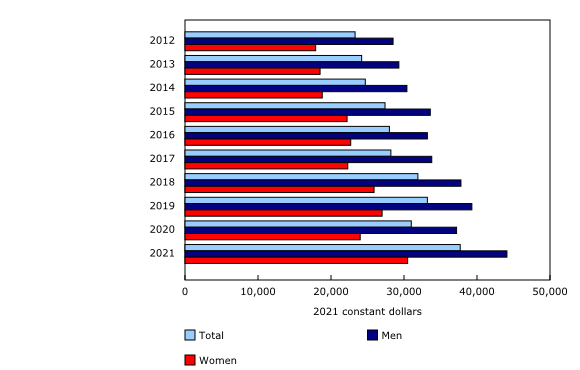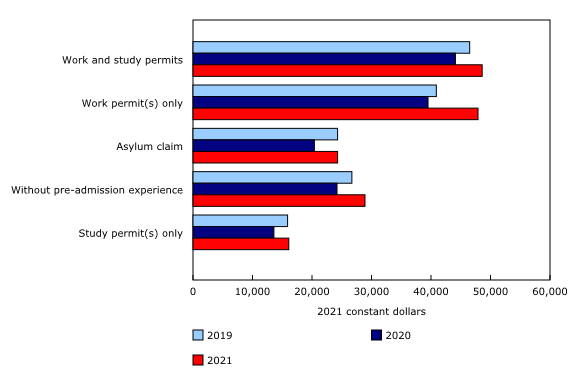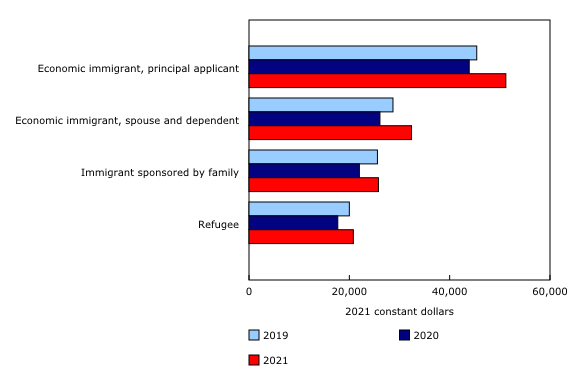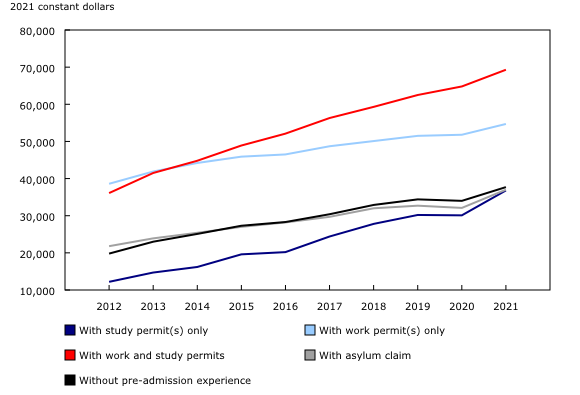The continued impacts of the COVID-19 pandemic: Variations in the economic integration of new immigrants
Released: 2024-01-22
The economic lockdowns and travel border restrictions during the first year of the COVID-19 pandemic impacted immigrants to Canada in many ways. Previous findings showed that immigrants admitted in 2019, just before the start of the pandemic, were particularly vulnerable. They experienced a drop in their median entry wage, reported one year after admission, unlike previously admitted immigrants, who saw consistently increasing median entry wages over the previous 10 years.
When examining the 2021 tax files of immigrants admitted in 2020, there was a steep drop in the number of taxfilers, especially for those who did not have pre-admission experience. In 2020, 184,575 immigrants were admitted to Canada, a 45.9% drop from 341,130 admissions in 2019. Despite this large decrease, a general bounce back in the median entry wage was observed among newly admitted immigrants, compared with their counterparts admitted in 2019.
This release explores immigrants' economic outcomes in the second year of the pandemic, 2021, focusing on new immigrants in the 2022 Longitudinal Immigration Database (IMDB). It will outline variations in the economic integration of newcomers by sex, admission categories and pre-admission experience. The IMDB is the result of a collaboration between Statistics Canada, Immigration and Refugees and Citizenship Canada, and the provinces.
The number of new immigrants who filed taxes in 2021 reached a 10-year record low
Based on immigrants' tax filing records one year after their admission, the 2020 admission cohort was the smallest in 10 years, in response to the pandemic border restrictions. As a result, the 2020 admission cohort was distinguished by immigrants holding pre-admission experience becoming the majority group for the first time in the country's history. Among tax filers in this admission cohort of immigrants, a higher proportion had already lived in Canada (55.5%) than those who did not have pre-admission experience (44.5%). In 2020, 22.5% of immigrant tax filers had both work and study permits, 22.3% had a work permit only, 8.5% had asylum claims and 1.9% had a study permit only. Such pre-admission characteristics were closely correlated with the outstanding economic performance of this admission cohort.
Median entry wages for immigrants admitted in 2020 rebounded and surpassed pre-pandemic levels
For immigrants admitted in 2020, the median entry wage, earned one year after admission, was the highest compared with the 10 previous admission years. In tax year 2021, the median entry wage of the 2020 newcomers was $37,700, 21.6% higher than that of the 2019 admission cohort when they filed for tax year 2020 ($31,000) and 13.6% higher than that of the 2018 admission cohort ($33,200 in tax year 2019).
In tax year 2021, the median entry wage for women admitted in 2020 increased by 27.1% to $30,500. In comparison, the median entry wage for women admitted in 2019 was $24,000 in tax year 2020. As for immigrant men admitted in 2020, the median entry wage was $44,100 in tax year 2021, higher by 18.5% from $37,200 in tax year 2020 for those admitted in 2019. Compared with the previous admission cohort, the median entry wage for women admitted in 2020 had a larger increase than their men counterparts. Despite this, women newcomers' median entry wage remained lower than that of their men counterparts by a large margin in 2021.
The median entry wage for 2020 newcomers with pre-admission work experience was the highest recorded since 2011
Gaining pre-admission experience in Canada, including work and/or study experience before admission, can help ease the integration of immigrants into Canadian society in many ways, such as by obtaining Canadian educational certificates and official language acquisition, as well as through experiencing culture in Canadian workplaces. As noted in an immigration publication, work-related pre-admission experience especially plays an important role in new immigrants' access to knowledge of the Canadian labour market, making it possible for them to boost their entry wages upon landing.
Among immigrants in 2020 with pre-admission experience, those with a study permit only prior to admission had the lowest median entry wage in 2021, at $16,100. This was similar to the median entry earnings of study permit holders admitted in 2018 ($15,900 in 2019). Asylum claimants in 2020 had a median entry wage identical to that of their 2018 counterparts ($24,300 in both years).
Immigrants admitted in 2020 with both work and study permits prior to admission had the highest median entry wage ($48,600 in 2021), 10.2% higher than that of 2019 taxfiling immigrants ($44,100 in 2020) and 4.5% higher than that of their 2018 counterparts ($46,500 in 2019). The 2020 new immigrants who held work permits only prior to admission earned a median entry wage of $47,900 in 2021, surpassing the median entry wage of the 2018 admission cohort by 17.1%.
New immigrants admitted either with or without pre-admission experience earned median entry wages higher than the pre-pandemic levels. Immigrants admitted without pre-admission experience in 2020 had a median entry wage of $28,900 in 2021, 8.2% higher than that of their counterparts admitted in 2018.
The 2021 median entry wages of all admission categories returned to or even surpassed the pre-pandemic levels
Economic principal applicants consistently earned the highest median entry wage, while refugees had the lowest median entry wage year over year. Among the three most recent admission cohorts from 2018 through 2020, economic principal applicants admitted in 2020 had the highest median entry wage ($51,200 in 2021), 16.6% higher than that of the 2019 admission cohort ($43,900 in 2020) and 12.8% higher than that of the 2018 admission cohort ($45,400 in 2019). Similarly, the median entry wage of spouses and dependents of economic immigrants admitted in 2020 was 12.9% higher than that of their counterparts admitted in 2018 ($28,700 in 2019).
Among refugees, the median entry wage for the 2020 admission cohort was $20,800 in 2021, 17.5% higher than that of the 2019 admission cohort ($17,700 in 2020) and 4.0% higher than that of the 2018 admission cohort ($20,000 in 2019). For family-sponsored immigrants admitted in 2020, the median entry wage of $25,800 in 2021 was about the same as that of their counterparts admitted in 2018 ($25,600 in 2019).
The second year of the pandemic had a restored growth in the median wage of immigrants admitted in 2011
A focus on the 2011 admission cohort enables an observation of immigrants' median wages over a 10-year period, from 2012 to 2021. The increasing trend in the median wage of immigrants admitted in 2011 was curbed in 2020, the first year of the pandemic, but returned to the rising trend in 2021. Overall, median wages of the 2011 admission cohort were about the same in 2019 and 2020, at $37,500, and rose by 9.6% to $41,100 in 2021.
Overall, comparisons of median entry wages among three admission cohorts from 2018 through 2020, as well as the long-term trend of median wages of the 2011 admission cohort, show that pre-admission experience plays an essential role in immigrants' economic integration in the Canadian labour market, whether they are newly landed or established immigrants.
Following the difficulties the previous cohort encountered in tax year 2020, immigrants admitted in 2020 experienced wage increases in 2021 regardless of immigration admission category, pre-admission experience and sex. During the pandemic, immigrants with work experience prior to admission were the least impacted by the adverse economic climate, which can be observed from the overtime wage trend of the 2011 admission cohort.
A second release that discusses immigrants' mobility in the second year of the pandemic will be released on February 14, 2024.
Did you know we have a mobile app?
Get timely access to data right at your fingertips by downloading the StatsCAN app, available for free on the App Store and on Google Play.
Note to readers
Definitions and concepts
The Longitudinal Immigration Database (IMDB) is a comprehensive source of data that plays a key role in understanding the economic behaviour of immigrants and non-permanent residents. It is the only annual Canadian dataset that allows users to study the characteristics of immigrants to Canada at time of admission and the economic outcomes and regional mobility of immigrants over a period of more than 40 years.
The IMDB is the result of a partnership between Statistics Canada, Immigration, Refugees and Citizenship Canada (IRCC), and the provinces. The IMDB combines administrative files on immigrant admissions and non-permanent resident permits from IRCC with tax files from the Canada Revenue Agency. IRCC's administrative records contain extensive information on immigrants admitted to Canada since 1952. They also include information on non-permanent residents who have been granted a temporary resident permit since 1980. Tax records for 1982 and subsequent years are available for immigrant taxfilers.
The IMDB links short-term and long-term outcomes to characteristics at admission, such as immigrant admission class, country of origin and knowledge of official languages. The IMDB also provides information on pre-admission experience in Canada and citizenship acquisition since 2005.
It is to be noted that the IMDB is updated annually. From year to year, there have been changes to data processing. Each yearly update is independent.
This release analyzes income based on the medians of wages (for the population with wages, salaries or commissions income, excluding self-employment income). The median is the income threshold at which a half of the immigrant taxfilers have higher income and the other half have lower. Zero values are not included in the calculation of medians for individuals. All income estimates are expressed in 2021 constant dollars to factor in inflation and enable comparisons across time in real terms.
Median entry wage in this analysis is the median wage reported one year after admission to Canada as a permanent resident.
Economic immigrant admission categories include immigrants who have been selected for their ability to contribute to Canada's economy through their ability to meet labour market needs, to own and manage or to build a business, to make a substantial investment, to create their own employment or to meet specific provincial or territorial labour market needs.
Immigrant-sponsored family categories include immigrants who were sponsored to come to Canada by a family member who is a Canadian citizen or permanent resident.
Refugee categories include immigrants who were granted permanent resident status on the basis of a well-founded fear of returning to their home country. These include government-assisted refugees, privately sponsored refugees, refugees admitted in Canada, and their dependents.
Principal applicant is the person submitting the immigration application and the individual being assessed on admission criteria under each of the admission categories, while their accompanying spouse and dependents are admitted automatically with the principal applicant.
Taxfilers are immigrants who have filed a tax return for a given taxation year.
For a more detailed description of the immigrant admission classes, see the IRCC Glossary.
Products
The Longitudinal Immigration Database 2022, including the wages and salary module (1997 to 2022), is now available upon request.
The publication "Longitudinal Immigration Database (IMDB) Technical Report, 2022" is now available as part of the series Analytical Studies: Methods and References (11-633-X).
The data visualization tool "Longitudinal Immigration Database (IMDB) Interactive Application: Economic Outcomes" is now available as part of the series Statistics Canada - Data Visualization Products (71-607-X).
The products are available on the Immigrant and Non-Permanent Resident Statistics portal. The Portal was designed to provide easy and free access to immigrant and non-permanent resident data and publications.
Information is organized into broad categories including analytical products, data products, reference materials and interactive applications.
Contact information
For more information, or to enquire about the concepts, methods or data quality of this release, contact us (toll-free 1-800-263-1136; 514-283-8300; infostats@statcan.gc.ca) or Media Relations (statcan.mediahotline-ligneinfomedias.statcan@statcan.gc.ca).
- Date modified:




